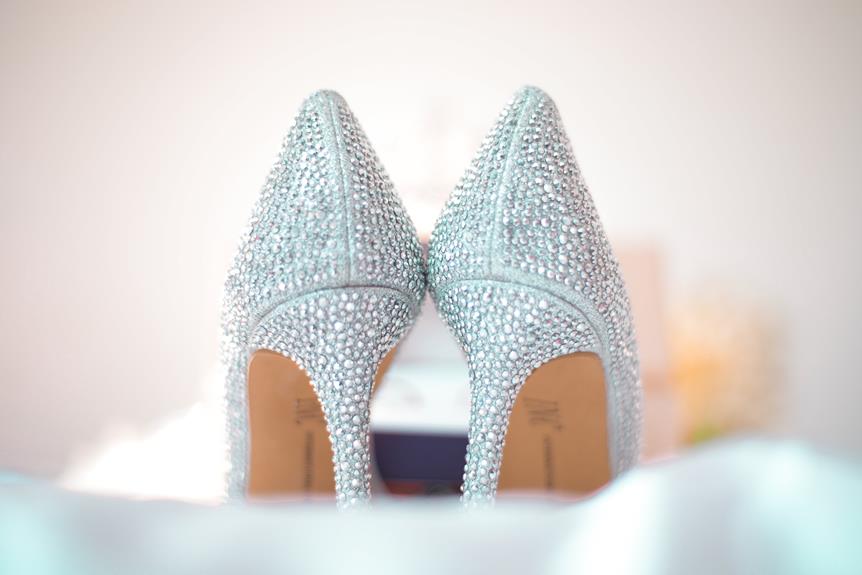Ever wondered if you could give your old shoes a fresh new look by gluing fabric to them? It's like giving your shoes a stylish makeover!
In this how-to guide, you'll learn the step-by-step process of transforming your shoes into unique fashion statements. From choosing the right fabric to applying it with precision, you'll master the art of fabricating your footwear.
Get ready to unleash your creativity and elevate your shoe game with this comprehensive and detailed guide. So, grab your supplies and let's dive into the world of shoe fabric gluing.
Your shoes are about to undergo a remarkable transformation!
Key Takeaways
- Choosing the right fabric is crucial for successful adhesion to shoes and should consider factors like material compatibility and design coordination.
- Proper preparation of the shoe surface, including cleaning and sanding, is essential for better adhesion.
- Selecting the appropriate adhesive based on fabric type, shoe material, and drying time is important for successful fabric-to-shoe bonding.
- Applying fabric to shoes can be done by folding and securing the edges with fabric glue or stitching, providing a polished and durable finish.
Choosing the Right Fabric
When gluing fabric to shoes, you should choose a fabric that adheres well to the shoe material and complements the design you have in mind. Consider the types of fabric available, such as cotton, canvas, denim, or synthetic materials like polyester or nylon. Each fabric type has its own unique characteristics, so it's important to select one that will work best with your shoes.
For instance, if you're working with leather shoes, a sturdy fabric like denim or canvas might be a good choice for durability and adhesion.
Color coordination is also crucial when choosing the right fabric for your shoes. Think about the overall look you want to achieve and select a fabric that will enhance the design. If you're aiming for a bold, vibrant style, opt for bright and colorful fabrics. On the other hand, if you prefer a more subtle and classic look, neutral or earthy tones might be the way to go.
Preparing the Shoes
Before you start gluing fabric to your shoes, it's important to prepare the surface.
Begin by thoroughly cleaning the shoes to remove any dirt, dust, or residue that could affect the adhesion of the fabric.
Then, lightly sand the shoe surface to create a slightly rough texture that will help the glue adhere better.
Cleaning the Shoes Thoroughly
First, thoroughly clean the shoes with a damp cloth to remove any dirt and debris. This step is crucial as it ensures that the glue will adhere properly to the shoe surface. Pay close attention to any areas with stubborn stains or residue. For tougher stains, you can use a gentle soap or specialized shoe cleaner.
After cleaning, allow the shoes to air dry completely before proceeding to the next step. It's important to remember that any remaining dirt or grime can interfere with the adhesive's ability to bond effectively.
Sanding the Shoe Surface
After cleaning the shoes thoroughly, you will need to sand the shoe surface to prepare it for gluing the fabric. Sanding the shoe surface is crucial as it creates a rough texture, allowing the glue to adhere more effectively. Here are some sanding techniques to help you prepare the shoes for fabric gluing:
| Sanding Technique | Description |
|---|---|
| Use Fine-grit Sandpaper | Gently sand the entire shoe surface to remove any shiny or smooth areas. This will help the glue bond properly. |
| Circular Motion | Sand in a circular motion to ensure even roughening of the shoe surface, promoting better adhesion. |
| Clean Thoroughly | After sanding, wipe the shoes with a damp cloth to remove any dust or debris before applying the fabric. |
Proper surface preparation through effective sanding techniques is crucial for a successful fabric-to-shoe adhesion.
Selecting the Right Adhesive
When it comes to selecting the right adhesive for gluing fabric to shoes, there are a few key points to consider.
You'll want to look for adhesives that are fabric-friendly and designed for use on footwear.
Understanding the different types of adhesives and proper application techniques will also be crucial for a successful and long-lasting bond.
Fabric-Friendly Adhesives
Once you have chosen the fabric for your shoes, it's important to select the right adhesive that will securely bond the fabric to the shoes and withstand wear and tear. When it comes to fabric-friendly adhesives for shoe customization and fabric bonding, consider these key factors to make the right choice:
- Flexibility: Look for adhesives specifically designed for fabric and shoe materials to ensure flexibility and prevent cracking or stiffness.
- Durability: Choose adhesives that are durable and can withstand the rigors of daily use, including walking, running, and different weather conditions.
- Quick Drying: Opt for adhesives that have a quick drying time to minimize the risk of the fabric shifting or wrinkling during the bonding process.
- Water Resistance: Select adhesives that offer water resistance to protect the bond from moisture and potential damage.
Understanding Different Types
To ensure a strong bond between fabric and shoes, selecting the right adhesive is crucial. When it comes to shoe customization, understanding the different types of adhesives is essential.
For fabric to adhere securely to shoes, you need to choose the right adhesive based on the materials involved. There are various types of adhesives suitable for fabric and shoes, such as contact cement, fabric glue, and epoxy.
Contact cement provides a durable bond and is suitable for heavy-duty fabrics, while fabric glue is ideal for lightweight materials. Epoxy, on the other hand, offers a strong and long-lasting bond for both porous and non-porous surfaces.
Understanding the properties and best uses of these adhesives will help you select the most appropriate one for your fabric-to-shoe project.
Proper Application Techniques
Selecting the right adhesive for your fabric-to-shoe project is crucial for ensuring a strong and long-lasting bond.
When choosing an adhesive, consider the fabric types and their durability. Certain adhesives work better with specific fabric compositions, so be mindful of this when making your selection.
Additionally, take into account the compatibility of the adhesive with the material of your shoes. Different shoe materials may require different adhesives for optimal bonding.
Furthermore, drying time is a crucial factor to consider. Some adhesives dry quickly, while others may take longer, so choose one that aligns with your project timeline.
Applying the Fabric
You'll need to ensure the fabric's edges are secure and won't fray when applying it to your shoes. Here's a quick guide to help you with the application process:
| Step | Instructions | Tips |
|---|---|---|
| 1. | Measure and cut the fabric | Use sharp fabric scissors to ensure clean edges. |
| 2. | Apply adhesive to the shoe surface | Use a brush or applicator for even coverage. |
| 3. | Press the fabric onto the shoe | Smooth out any wrinkles or air bubbles. |
| 4. | Allow the adhesive to dry | Follow the manufacturer's recommended drying time. |
When choosing fabric types, consider durability. Thicker, woven fabrics like denim or canvas are often more durable and easier to work with. For adhesive application, be generous but not excessive, and be mindful of the drying time to avoid smudges or uneven adhesion. By following these steps and considering fabric types and adhesive application, you can ensure a successful application of fabric to your shoes.
Securing the Edges
For securing the edges of the fabric on your shoes, ensure a clean and tight fit by trimming any excess fabric and pressing it firmly against the shoe surface. This will give your shoes a professional and polished look.
Here's how to secure the edges effectively:
- Edge Reinforcement: Fold the fabric over the edges of the shoes and use a small amount of fabric glue to secure the folds in place. This will prevent fraying and give the edges a clean finish.
- Fabric Folding: When folding the fabric over the edges, ensure it's smooth and taut to avoid any wrinkles or bulges. This will create a neat and seamless transition from the shoe surface to the edges.
- Stitching Alternatives: If you prefer a more durable option, consider using a thin needle and thread to carefully stitch the folded fabric to the shoe. This hand-sewn method provides a secure hold and a classic finish.
- Adhesive Options: For a quicker alternative, opt for a strong fabric adhesive to bond the folded fabric to the shoe edges. Be sure to choose an adhesive specifically designed for fabric and shoe materials for the best results.
Finishing Touches and Care
To complete the fabric-to-shoe process, you should now focus on caring for and adding finishing touches to your newly customized footwear. Preventing fraying and extending longevity of your fabric-to-shoe creation is essential for maintaining its quality. Here are some tips to ensure your customized shoes stay in great condition:
| Finishing Touches | Care Tips |
|---|---|
| Apply a fabric sealant to the edges of the fabric to prevent fraying. | Clean your shoes regularly by gently wiping them with a damp cloth. |
| Trim any loose threads to maintain a neat and polished look. | Use a soft brush to remove dirt and debris from the fabric. |
| Add decorative elements like ribbon laces or embellishments for a unique touch. | Store your shoes in a cool, dry place to prevent mold and mildew. |
Taking these steps will not only enhance the appearance of your customized shoes but also ensure their durability. By preventing fraying and regularly caring for your fabric-to-shoe creation, you can extend its longevity and enjoy your unique footwear for a long time.
Frequently Asked Questions
Can I Use Regular Fabric Glue to Attach Fabric to Shoes?
You can use regular fabric glue to attach fabric to shoes, as it's one of the fabric glue options for shoe customization techniques. It's a convenient and effective way to personalize your footwear.
Will the Fabric Stay Attached if I Wear the Shoes in the Rain?
Yes, the fabric should stay attached if you wear the shoes in rainy weather, but long term durability may be affected. It's best to avoid exposing the fabric to prolonged moisture for optimal results.
Can I Remove the Fabric From the Shoes if I Change My Mind?
Yes, you can remove the fabric from the shoes if you change your mind. Gently peel off the fabric and use a fabric-safe adhesive remover to clean any residue. When reattaching fabric, ensure the surface is clean and dry for better adhesion.
Will the Fabric Cause the Shoes to Stretch or Become Misshapen?
Fabric can cause shoes to stretch, affecting their shape. To prevent stretching and maintain your shoes, consider using a stable adhesive and minimizing the amount of fabric applied to key stress points.
Can I Wash the Shoes With the Fabric Attached?
You can wash the shoes with the fabric attached, but follow the specific washing instructions for the fabric you used. The durability of the fabric will depend on the type and quality, so choose wisely.
- Does Chiffon Fabric Stink - July 15, 2025
- Does Chiffon Fabric Affect the Economy - July 15, 2025
- Does Cotton Fabric Have a Nap - July 15, 2025







